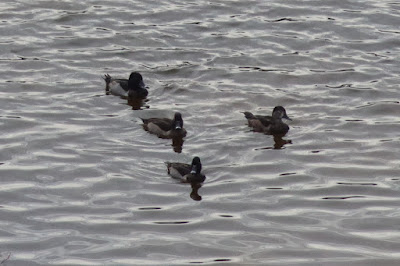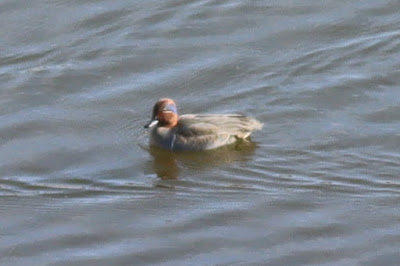Male Green-winged Teal (Anas carolinensis)
A trip to the Laguna de Barlovento this morning led to an interesting find: a male Green-winged Teal (Anas carolinensis) accompanied by 4 females.
Male Green-winged Teal (Anas carolinensis)
Observation conditions at this reservoir are always difficult: birds are distant and visibility is confined to a few gaps in the surrounding fence and/or vegetation. A spotting-scope was used to identify the ducks on this occasion, before these poor quality images were captured.

Male Green-winged Teal (Anas carolinensis) and one of the accompanying females
According to "Rare Birds of the Canary Islands" (Lynx Edicions), this long-distance migrant breeds in northern USA and winters in Honduras. It is the fifth most recorded American duck in the Canary Islands, surprisingly less frequent than Blue-winged Teal (Anas discors). As of publication in June 2013, there had been 11 accepted records in the archipelago, mostly from Tenerife.
Since then, other sightings have probably been added to the total.
Male Green-winged Teal (Anas carolinensis), with Common Coot (Fulica atra)
Birds reported on this side of the Atlantic tend to be males, which are easy to identify by the vertical white stripe on either side of the breast, and by the reduced yellow lines on the side of the head, when compared with the Common or Eurasian Teal (Anas crecca). Assigning females to one or other (sub-) species poses serious problems in the field.
Male Green-winged Teal (Anas carolinensis)
This American duck is still classed as a rarity in Spain, so details will be forwarded to the Spanish Rarities Committee once the bird flies on.
Male Green-winged Teal (Anas carolinensis)
Male Green-winged Teal (Anas carolinensis) with female Teal sp.

































